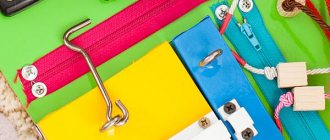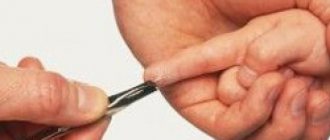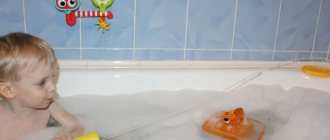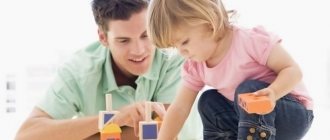What to do with a child one year old and older? This question is very important for many parents, since at this age he is able to independently paint wallpaper, a sofa, other furniture, pour water into all the cabinets and other “pleasant” activities for his mother.
Let's help the baby and offer him a lot of entertaining games and activities that will not only help the mother get some rest, but also influence the child's development. There are 2 types of things to do for a 1-1.5 year old child: playing with mom/other loved ones or spending time on their own.
Development of one and a half year old children
A child of one and a half years continues to actively explore the space around him, both on the street and at home.
This is facilitated by improved coordination of movements, as well as a level of intelligence that significantly exceeds that of a one-year-old baby.
The physical development of a child 1 year 6 months slows down somewhat, but active development of personality and character formation occurs.
Physical
A sufficient level of physical activity for a one and a half year old baby is the key to the fact that he will learn to properly control his body, improve coordination of movements and previously acquired skills. The task of parents is not to limit, but to provide a safe space in which the child can develop harmoniously.
Baby's physical skills at 18 months:
- walks confidently in all directions, avoiding obstacles, and masters running. At the same time, he begins to look at his feet, stumbles and falls less than a few months earlier;
- able to climb onto furniture and then get down from it (chairs, sofas, beds);
- knows how to kick a ball with his foot;
- eats himself while sitting on a highchair, drinks from a cup, occasionally pouring himself over;
- walks well on stairs with support;
- can throw the ball with his hand;
- to pick up a fallen object, he simply bends down, and does not sit next to it, as was the case before;
- actively opens cabinet doors and shakes everything out;
- opens doors to rooms;
- squats down.
The weight and height of a child at one and a half years depends on birth weight, nutritional habits, activity level and other factors. Average figures for boys: 11.7 kg and 82 cm, respectively, for girls - 11 kg and 80.3 cm.
Neuropsychic
“I myself!”
- this is exactly the motto that a baby of 1 year 6 months follows, at the same time, the baby is very emotional and demanding in his desires. At this age, the child actively imitates adults and uses household objects as toys. Mom's saucepan with a lid can be much more interesting than a whole bag of bright educational toys. The emotional sphere becomes more developed: the baby is happy when he meets his family, he can try to calm him down if someone is crying nearby, he gets upset when something doesn’t work out, etc.
Babies are able to easily “switch”, that is, sobs over mom’s ban on trying to touch a hot iron can be replaced by cheerful laughter within 20 seconds. Almost all children aged one and a half years love to dance to music.
The biggest fear of a one and a half year old baby is separation from loved ones. Psychological vulnerability at this age is extremely high. An 18-month-old baby enjoys drawing doodles on a piece of paper using a pencil, felt-tip pen or pen.
The main difficulty of this period of life is the active manifestation of negative emotions, for which not all parents are ready.
The reasons may be trivial: they didn’t give you something forbidden, you can’t build a turret. Psychologists in such a situation advise parents to find ways to quickly distract the child and switch his attention to something else.
Intellectual
At 18 months there is a big leap in the development of speech skills. The baby is already making attempts to construct word combinations and understands the meaning of almost all phrases spoken to him. Fulfills simple requests, for example: “give me an apple from the table” or “open the lid of the box.”
A 1.5 year old child can also:
- play sorter, choosing the right figures;
- knows where the cube is and where the ball or brick is;
- collects a pyramid;
- shows objects at the request of an adult;
- knows 2-3 colors, can distinguish between the concepts “big and small”;
- uses objects in the game according to their purpose;
- knows how to push a stroller or cart in front of him, pulls a toy by a string;
- shows intelligence, for example, if you need to reach an object at a height, he substitutes a chair;
- speaks up to 40 simple words;
- tries to comb his hair, dress himself, and wash himself.
The age of 18 months is ideal for toilet training - if previously the baby used this accessory more intuitively or did not know how to do it at all, now he begins to understand the connection: “I want to go to the toilet, I use the potty.”
Summary
The proposed options for what to do with a child of one year and 1.5 years will definitely help any mother in entertainment, as well as in the development of the baby. Games give him pleasure and are a form of activity in which he develops. Educational games teach children one year and older not only to listen, but also to hear, listen attentively to your explanation, follow your demands and instructions, contribute to the formation of children’s general mental abilities, develop the ability to focus their attention, and act purposefully.
How to develop a child?
The development of a one and a half year old child should be comprehensive. To replenish your vocabulary, expand your horizons and improve your memory, you need to use books, cubes and cards with images of animals, plants, modes of transport and other things. It is useful to read poems, nursery rhymes, and fairy tales to children.
The following toys will also help in deciding how to develop a child of one and a half years:
- musical instruments: piano, trumpet, drum, etc. Such toys will help the baby develop proper hearing;
- dishes, dolls and furniture for them, sets of fruits and vegetables, animal figurines. All this will help organize exciting role-playing games;
- lacing, simple construction sets, labyrinths are indispensable items for stimulating fine motor skills;
- a ball, a rolling toy, as well as all kinds of rocking chairs (matryoshka dolls, tumblers, etc.) will help develop motor activity;
- You can form an idea of the colors, shapes and sizes of objects using sorters, multi-colored cups, special sets for the sandbox, logic cubes and other things;
- A busy board or a Montessori board would also be useful. This is a popular toy that contains locks, gears, zippers and other objects that a child encounters in everyday life.
Experts advise to be sure to praise the baby for any, even the most insignificant, successes and achievements.
Didactic games - we develop the baby’s cognitive activity during the game!
It would seem, what can you play with such a toddler! Yes, so as not only to enjoy communication, but also to receive useful results - new knowledge and skills of the child. We offer you several educational subject games, simple but aimed at achieving high goals, here are just a few of them:
The purpose of didactic games for a child:
• Develop the child’s ability to act in space, and at the same time act coordinatedly or synchronously with the right and left hands; • Enrich the baby’s sensory experience by inviting him to interact with objects and toys of different physical properties; • Develop the tenacity and strength of the baby’s fingers – fine motor skills of his little hands; • Try to complete tasks with objects of the same color or size, focusing on one of these properties; • Try to solve problems: choosing an object according to its property, and at the same time try not to be distracted by other properties of objects that are not related to the task - that is, teach purposefulness.
Approximate methods of didactic educational games:
1. Ball, ring, cube….
Goal: To teach the child to act with objects depending on their physical properties, explain to the child. For example, you can only put a ring on the rod of a pyramid, but you can’t put a ball on it, since there is no hole in it. It’s also not possible to make a tower out of balls; the best material for this purpose is cubes...
Material: Pyramid rings, cardboard circles.
Progress of the lesson:
- Show your baby the colorful rings. Roll one ring on the floor first, then the second, then the third. Explain: “This is a ring. And this is a circle!” (show it). Then show how the ring is strung on the column of the pyramid. “Look, you can put a ring on a post, but you can’t put a circle on it, because there’s no hole in the circle!” (Show).
- Take rings and circles mixed together, roll them out and place them on the floor. A one and a half year old baby can already be asked to sort, collect circles and rings separately. The circles can be placed in a basket, and the rings can be strung on a stand toy. Encourage your child - if the action is performed correctly, note its results.
2. “Matryoshka Girlfriend”
Goal: To teach the child to play with collapsible toys (matryoshka).
Material: Matryoshka doll, inside it there is a colored handkerchief.
Progress of the lesson:
- Place a house on the table, behind which you hide a nesting doll, and say that a matryoshka lives in the house. “Let's call her! Matryoshka, come to us!”
- “Matryoshka has prepared a gift for you: let’s open it and see what she brought us!” Show how the nesting doll opens (in a vertical position). Help your child open the nesting doll if he can’t do it for a long time. Guide his hand, convey light force, placing your hand on his handle and on the matryoshka. Or you can first put a loop of tape inside and use it to tighten the upper part of the toy.
- Together with your child, look at the handkerchief taken from the nesting doll. Describe its properties and drawing in words.
- Then invite your child to close the nesting doll, first combine its parts, then press them together more tightly.
Note: in the future you can complicate the game by using not just one nesting doll, but several.
3. “Into the forest, picking mushrooms...”
Goal: To teach the child to act with objects, taking into account their position in space, shape, size. Learn to perform sorting tasks - selecting objects with the same properties, focusing on one of them (color or size).
Material: Mushrooms of the same color and two sizes - 3 -5 pcs. Note: they can be drawn on cardboard and cut out, or made like this: the mushroom legs are spools of thread, and the caps are pieces of foam rubber covered with fabric.
Progress of the lesson:
- Place the mushrooms throughout the room so that the baby may not immediately find them, but, for example, by bending down and looking under the high chair. Give your child a basket (box) and show him how to pick mushrooms.
- When all the mushrooms are in the basket, examine them with your child. Then invite your child to divide the mushrooms by size - large ones in one direction (for example, for a large toy), and small ones in the other (for a small one).
Note: Such classes are conducted with mushrooms of different colors and the same size, or also of different shapes, but the same size.
Age-appropriate educational games and cartoons
Child psychologists do not recommend allowing your child to spend a lot of time watching TV - this applies not only to those moments when the child is watching it, but also to those moments when the device is running in the background. This creates excessive stress on the psyche.
If the need to watch TV arises, you can give preference to educational programs created specifically for young children.
These include: “Kids”, “Woods”, “Tini Love” and others. Games that can keep your baby 1 year and 6 months occupied:
- any role-playing activities. You can cook in a toy kitchen, roll a doll in a stroller, repair cars with tools, etc.;
- "catch-up". The task is simple: the baby must run after his mother. Duration - no more than 30-40 seconds, then a break is needed;
- modeling;
- simple puzzles consisting of 2 elements;
- playing with sand and water. It is especially useful to pour or pour them into different containers;
- Inset frames are an excellent trainer for logic and fine motor skills.
When choosing a game, it is important to remember that it should bring joy and pleasure to both sides of the process.
Psychologists recommend giving preference to the most realistic models. A bunny, for example, should be similar to its prototype - then the child will form a correct idea of the surrounding reality.
How to do and what to play with a one and a half year old child - games for babies at 1 year and 6 months
Of course, reading continues to be a source of new words and knowledge, broadening one’s horizons. There is no need to be afraid that the baby will not understand some words in the fairy tale or will not understand a complex sentence. After all, it is precisely listening to new words and speech structures over and over again that gives impetus to the further development of speech. It is important not to get carried away and not set the goal of mastering as many books as possible. Choose 4-5 of your favorites and re-read them periodically, gradually adding new ones. At the age of one and six months, children are very happy when they hear an already familiar text, when they imagine what will be discussed next.
Talk actively while walking with your baby , using as many adjectives and characteristics of surrounding objects as possible.
It’s just great to act out mini-scenes with two or three toy characters (for example, rubber ones) in front of your child. These can be both everyday scenes (toys sat down, ate and went for a walk), or acquaintance, for example, with the voices of animals, their diet, and cubs.
Teach your baby to hygiene: teach him to wash his hands, face, dry himself with a towel, put away toys, go to the potty.
Modeling from salt dough Prepare the mixture for modeling: 4 tablespoons of salt, 2 cups of flour, water. It should be a stiff dough. Make figures of animals, fruits, and vegetables from it with your child. If your baby accidentally swallows a piece, there is nothing to worry about, the mass is safe. Dried crafts can be painted. Blow out the candle Light a candle and have your child blow it out. Exercise promotes the development of a child's lungs.
Don't forget about safety precautions so that you and your child don't get burned!
Hide and seek Mom or another loved one hides, but at the same time constantly makes a voice, for example, saying “ku-ku”. The child is looking.
Comment from pediatrician Oksana Olegovna Ageeva:Reading picture books, telling stories to a child and games that involve hands (modeling, drawing, putting together puzzles) develop the child’s brain and imagination very well.
What toys will benefit your baby?
Firstly, toys are selected according to age. Secondly, they must be of high quality and safe. You should not purchase models with sharp edges or corners, peeling paint, or other visible defects.
Thirdly, it would be a good idea to choose toys that can be easily washed or wiped down.
It is worth excluding the use of models that are equipped with a sound module that is too loud - shooting, squeaking or emitting other sharp sounds.
Didactic games: we develop the baby’s cognitive activity during the game!
The goal of all these games is to teach the baby to perform interconnected direct and reverse actions with objects .
For example: laying out and assembling, taking out and putting in, putting balls into a box, bucket, rolling them along a groove, laying out and collecting colored inserts, stringing a pyramid, putting hollow objects (smaller into larger). Such games will develop the child’s cognitive activity, fine motor skills, enrich his sensory experience, mental activity - the first concepts of analysis and synthesis, comparison and first generalizations in the baby’s mind.
When playing with a child, you need to use objects made from various materials - metal, wood, polyethylene, paper, fabric. It would be great if the toys made different sounds.
Let's play with cubes
Goals:
In practical activities, introduce the child to the features of a cube - a stable geometric figure that has identical edges. Tentatively give the child an idea of the properties of filled and hollow containers.
You will need:
Set of cubes. The cubes (approx. 4 cm edge) are placed in boxes with lids, the lids are closed. The boxes should be different in shape (for example: flat and tall).
A game:
• Rattle the flat box and give it to the child, ask: “What’s in there?” The baby opens it and takes out one cube at a time. At the end, the empty box is shown to the baby: “No! there is nothing!" The box is closed with a lid and shaken again: “It doesn’t rattle. An empty box,” you explain to the baby. • Then the baby is offered a tall box, the mother shakes the box: “Knock, knock! What's there?" Tilt the tall box and, one by one, shaking it out, hand the baby cube by cube (this is how the sequence of actions with objects is observed). When the box is empty, the baby is asked to look into it and shake it: “No! There is nothing!" • In the third part of the lesson, together with your child, build a tower (you place the cubes one on top of the other - vertically), and then a train (you place the cubes one on top of the other in a horizontal plane).
Lesson on earbuds
Goals:
On an emotional-sensory, indicative basis, introduce the child to conical-shaped objects (hollow cones of different colors and sizes) - “caps”.
You will need:
A set of inserts-caps, sequentially inserted into one another. The color of the caps can be chosen arbitrarily or in accordance with the main colors of the spectrum.
A game:
• Place a toy in front of the baby - caps placed sequentially one inside the other. The child sees only the top, largest cap. Move the entire structure towards the baby and offer to remove the top cap, then the next one, and what’s under it. Talk about the shape and colors of each cap, try to arrange them sequentially (in a row) one after the other. • Then, in front of the child’s eyes, “roll up” all the caps, sequentially covering the smaller cap with the larger one. All this is accompanied by a cheerful conversation, played out emotionally - “Let's hide the cap!” Give your baby the opportunity to act with the caps the way he wants. • You can then show how you can build a beautiful tower from the caps by placing each smaller cap successively on top of the larger one. Or maybe your baby will figure it out on his own?
What a nesting doll!
Goals:
Introduce the child to the folding design of a nesting doll: from one, large, a second, small one appears, and so on.
You will need:
Two toys - nesting dolls - large and small. Make 2 tables for them (one larger, the other smaller) - from boxes, or by bending cardboard. And also a “tea set” - cups, if there are no toy ones, can be made from a nut shell or a thin paper strip rolled into a spiral - this will only further develop the baby’s imagination.
A game:
• Come up with an entertaining storyline for playing with nesting dolls. For example, they can dance, play hide and seek, ride on cars, hide under a handkerchief in front of the baby. And let him discover them under the handkerchief. • Consolidate the knowledge your child has acquired by comparing nesting dolls of different sizes. Voice the nesting dolls - as if saying for them: “I am a big doll!” (said in a Basque drawl), “And I’m small!” (small voice, spoken quickly). Placing one or another toy in the baby’s hands, ask him to show where the “big” and where the “small” nesting doll is. • At the end of the lesson, offer to “give” them tea and treat them. Matryoshka dolls are placed at makeshift tables. Large - at a high (large) table; small - for low (small). Vividly play up the situation of drinking tea, and then let the nesting dolls thank the child. • Next, the baby plays with the nesting dolls freely as he wants.
Assembling a pyramid
Goals:
You need to teach your child to perform the action of threading on a rod. It is useful to practice two grips - with your fingertips, grasping it from above, or with your thumb and forefinger, grasping it from the side.
You will need:
Pyramid - colored rings on a rod (5-6 pieces).
A game:
• There are 5-6 rings of the same size in front of the child. Encourage your child to take the ring in his hands, run his palm over the surface, try to place it on the side surface, roll it left and right; teach your child to grab the ring with your fingertips - “rehearse” two grips - grasping the ring from above and from the side. Use all the possibilities of the pyramid - tell about the colors, the shape of the rings, show where the big one is and where the small one is. • Invitingly suggest to the baby: “Let’s build a pyramid!” Then show how it’s done - put the first ring on the rod yourself. Then invite the child to repeat this action - give him the ring and say, “Now you!” If the baby finds it difficult, then perform the action with his hand, or repeat the demonstration again. • You can use a sound technique: the ring, having passed through the rod, lowers, falling on the support, makes a sound. “Knock!” – cheerfully comment on the sound, and let the child repeat after you. Then the pyramid is assembled completely. Be sure to focus the child’s attention on the result of his “work” - “Oh, what a wonderful pyramid it turned out to be - multi-colored!” • If the child remains interested, you can repeat the game with rings from the beginning.
Activity with balls
Goals:
In the process of practical actions, on an emotional-sensory, indicative basis, introduce the child to the shape of a ball, teach him to perform actions with objects, taking into account their shape and position in space. Develop the ability to pick up a ball with your fingertips and roll it onto a tray.
You will need:
Balloons. Tray for rolling balls. It can be made from cardboard. The lesson can be done while sitting on the carpet.
A game:
• Offer your child a box of balloons. Let him play with the box, pick out the balls, and watch them roll out. Roll one or the other ball towards the child. • Then take the box and invite the baby to give you the balls one by one, which you collect again in the box. • In the next part of the lesson, teach your child to roll the balls along the groove. They roll out again. Collecting the balls into a box and rolling them out is repeated several times.
Game "What's in the saucepan?"
Goals:
Introduce the child to various objects, colors, and help him remember their names. You will need: A set of “vegetables and fruits” (carrots, cucumbers, turnips, tomatoes), a saucepan with a lid. A set of “vegetables” is placed in the saucepan in advance and covered with a lid (you can replace the set with real vegetables and fruits, after washing and drying them).
A game:
Give your child the treasured saucepan: “What’s in there?” The baby opens the lid and takes vegetables and fruits. Offer to consider them. Place them one by one in the child’s hands, ask them to run their fingertips along the surface of each object. Comment: “This is a cucumber, a green cucumber, and this is a carrot.” Then the items are put back into the saucepan. The lesson is repeated.
Story game
Continue playing story games with your baby: show everyday situations with dolls and animal toys, over time complicating the content of the scenes. Especially to an adult, rationally thinking parent, at first glance it may seem that a story game is a rather boring activity. But this is not so - imagine that you are the director of a small theater, and the viewer is your own child, and you need to perform your roles so believably as to not only attract the attention of the “hero of the occasion,” but also entice him to participate in this action!
Experiment in the game, turn on your imagination. In order to truly captivate a child with a game, you need to forget yourself for a while, return to childhood... and get carried away by it yourself! It costs a lot, but it works flawlessly - your baby will love to play games - and it’s great if you, the person dearest to him, help him with this. And the importance of the game for the formation of a person’s personality is difficult to overestimate. It is no coincidence that the famous Russian teacher L. S. Vygotsky called play “the ninth wave of child development.”
“Love childhood; encourage his games, his fun, his sweet instinct. Who among you has not sometimes regretted this age, when there is always laughter on the lips, and there is always peace in the soul?” Jean-Jacques Rousseau
What is useful to do in a story game:
• Reflect in the game a sequential chain of routine moments that usually occur with the baby (walking, feeding, bathing, going to bed) - this will help the baby better draw parallels in his own life and understand the relationship between these actions.
• The game also reinforces the baby’s ideas about reality, therefore, in the same way – as in reality – introduce the child to items of doll clothes, furniture and dishes . It’s good if their arsenal is varied (dishes of different colors and shapes, a full wardrobe of doll clothes - for all occasions).
It often happens that a small child, especially a boy, has “stacks,” as they say, of plastic cars and robots, but there are absolutely no doll items for the plot game. This is wrong, because a boy is also a person - and he needs a boy doll, approximately his age - with all the “outfits” - for story games. We will talk about the arsenal of toys for boys in another article, as well as how to choose the right toys in the store.
This is wrong, because a boy is also a person - and he needs a boy doll, approximately his age - with all the “outfits” - for story games. We will talk about the arsenal of toys for boys in another article, as well as how to choose the right toys in the store.
• To diversify the game and nourish the child’s cognitive interest, include in the game plots pictures depicting birds and animals: a goose, a hen, chickens, a goat, a kitty, a bunny.
Sample story games for children:
Meeting the doll
Purpose: Presentation of a new toy to the child, the game is combined with a description of the toy, using poetry, poems, songs and nursery rhymes.
We will need: A medium-sized doll (30-40 cm) - corresponding to the gender of the child (girls - girl dolls, boys - boys)
Progress of the lesson:
Let's look at the game using the example of the Katya doll: • Show the baby the doll. Let the doll “speak” to him: “Hello! What is your name?". Pay the little one's attention to the doll's beautiful dress. • A small scene is played out here. For example, the song and dance of a doll. Say: “Katya doll wants to sing a song for you and dance.” Next, to the tunes of a cheerful song (folk songs are good: “In the garden or in the vegetable garden”, “Oh, you canopy, my canopy”), the doll “dances” (swing it, let it “jump” forward/backward, turn it - spinning). You can also use audio recordings of children's songs, and there will also be nursery rhymes:
Oh, what a dress Alena has, and what a green border! My heel, stomp harder and dance - spin more merrily!
Katya, little Katya, remote Katya. Walk along the path, Katya.. Stomp Katya with your little foot!
Note: story play, as opposed to play with a doll, for the period from 1 year 3 months to 1 year 6 months. It differs in this way: now, not just individual actions with a doll are played out (feeding, combing, etc.), but already plot-based, detailed dramatizations, using various accessories and additional toys.
As, for example, in a game like: “Doll Katya treats her friends.” It would be appropriate here to give an idea of the proper names of toy animals (Muska the cat, Quack the duckling, Burenka the cow). In future shows, plots should be enriched by including these characters in the actions.
Kitty and Goat
Goal: To consolidate the names of toys (cat and goat) in the child’s speech – at least simplified ones. Teach to imitate animal voices (“meow-meow” and “me-e-me-e”).
We will need: Toys - a cat and a goat, corresponding pictures (or other animals, at your discretion).
Progress of the lesson:
• First you need to show the baby pictures of animals, name them, pronounce onomatopoeia to their voices. Using the example of a cat and a goat: “Meow! Meow!" and “Me-e-Me-e!” Ask your child to repeat.
• Next, with elements of surprise – we include toys in the game. The baby will be especially interested in the “hide and seek” technique - toys “hide” in different places and make “voices”, and the child finds them. It would be great if every time he manages to find a toy, immediately ask him to name the animal and show him how it “speaks.”
• At the end of the lesson, we again draw the child’s attention to the picture, ask him to name who is drawn in it and how he can “speak.” Note: various poems are well suited to such games, for example, A. Barto “Who screams?”
Who screams Ku-ka-re-ku! I look after the chickens. Where, whack, whack! She got carried away in the bushes. Drink, drink, drink! Drink some water. Murr-murr... I'm scaring the chickens. Kra, kra, kra! Tomorrow it will rain in the morning. Moo, moo! Milk for anyone?
Puppet theater (glove puppets) – example: “Petrushka”
Goal: Getting to know Petrushka, a folklore character. Enrich the baby's emotional impressions. Use the surprise moment - the appearance of Parsley - to increase interest in the situation being played out and develop the child’s speech.
We will need: A glove puppet, in our example - Parsley.
Progress of the lesson:
• Put the doll on your hand and hide it behind your back or in your pocket. We act out the scene of Parsley's surprise appearance. Show by example - surprise, joy, introduce Parsley to the baby. You play for two people - yourself and Petrushka.
• Parsley “plays”: it hides in different places and suddenly appears. Greets the baby by the hand and asks questions. The same as in playing with a doll - you can show how Petrushka sings and dances, and even plays musical instruments.
• Next, the game unfolds according to the situation, which depends on the baby’s desire to talk, play, and act together with Parsley.
The article was compiled in accordance with the recommendations of Lyubov Pavlova (leading researcher named after A.B. Zaporozhets, candidate of psychological sciences).










